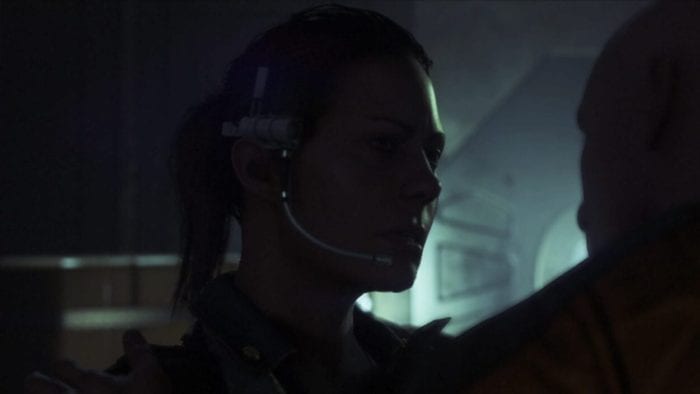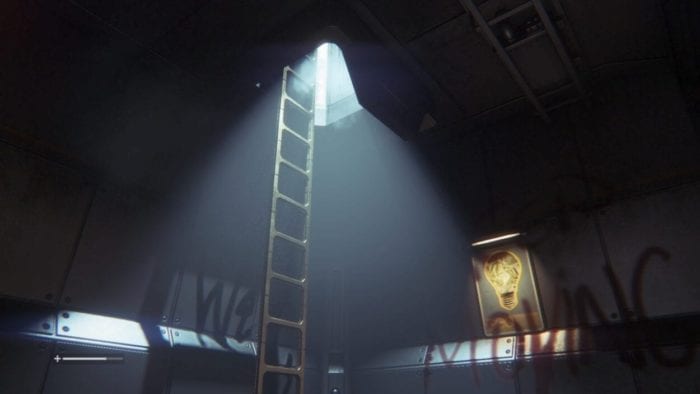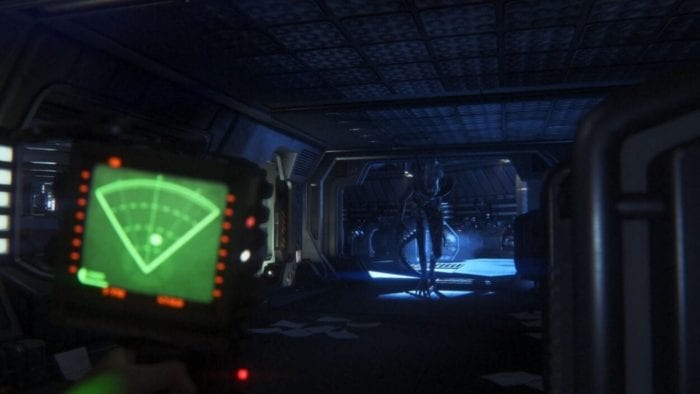So, you’re in this huge room. It looks like an airport departure lounge, with a mezzanine and booths and staircases. At the end is a door through which you can gain access to the lift. It’s locked of course, as you’ll find with many doors in this place. To unlock it you’ll need to use a gadget called a security access tuner. That will involve just turning your back on the room for fifteen seconds or so. Not a problem, surely? Oh yes, in the words of Virginia Madsen in Dune, “I forgot to tell you something.” There’s a seven-foot-tall xenomorph prowling around the room.
You’ve just watched this thing eviscerate some other unfortunate people and it can sense that you’re there. It’s looking for you; not in the way other NPCs you might have met in your gaming life will. It doesn’t have a little question mark above its head that disappears after a while. It won’t forget about you after a few seconds and walk off, following a set routine of walking to the corner, facing the room for ten seconds then walking to the other corner, staring at the wall inexplicably for ten seconds, etc. This thing goes where it wants, when it wants. Hide in the cupboard too long and it’ll figure out that’s where you are. If it hears you, it will rip you apart; if it sees you, the same. You can’t outrun it. None of your weapons (if you even have any) will kill it. It can’t be bargained with; it can’t be reasoned with (I’m really mixing my sci-fi metaphors here, aren’t I? I’ll stop, promise!).
So, after hiding under tables, peeking around corners and listening for footsteps for what seems like an age, you have to go for the door. You creep all the way there, slowly, ever so slowly, desperate to avoid that tell-tale hiss and thud of footsteps that tells you you’ve been discovered. Then you reach the door, and all the time you are using the access tuner, you know that you are out in the open and, if it happens to glance your way, there’s nothing you can do. Maybe this time you’ll make it. Each time you try, your heart is pumping out of your chest as you sit on a sofa (with the lights off if you’re really brave), your controller trembling in your clammy hands, in a state of panic that no horror film you’ve ever watched has ever induced. This is you in this room. You ARE Amanda Ripley, and this thing is out to get you.

That scene happens quite early on in 2014’s Alien: Isolation. It’s your first encounter with the alien and it really rams home the point of the game. It isn’t about winning; it’s about surviving.
Just mention this game on a Facebook group and see what happens. You’re inundated by people saying how great it is but they couldn’t finish it or go on past a certain point because it was too stressful or scary. That’s rarely something you read about other games. Designed by Creative Assembly and published by Sega, Alien: Isolation is set 15 years after the events of the original Ridley Scott film. Amanda Ripley is the daughter of Sigourney Weaver’s Ellen from that film and its sequels. Amanda visits a space station called Sevastopol in order to find clues about her mother’s disappearance. What she finds is a place where something horrible has happened.
As the game unfolds, you uncover more of the truth about what has gone on as you try and evade not just the hostile alien but also other people and, perhaps most creepy of all, the staff of Working Joes – androids who can quite easily beat you to death if they think you are in the wrong place. All these other threats you can deal with using weaponry you find or build around the station. Ammunition is in desperately short supply, however, and all that noise from gunfire or fighting can easily attract the attention of the apex predator on the site, from which there is little chance of escape. You spend your time rifling through cupboards and drawers (and bodies) to find bits of scrap that you can fashion into things to distract the alien and buy you some time or space to get away.

Creative Assembly wanted to strip away all of the pulse rifles and grenades of other gaming forays into the Alien mythology. They replaced them with a visceral horror experience that would take players back to the feeling of desperation that existed in the original film. Their success in this is absolute and what you experience during the lengthy single player campaign is perhaps the best addition to the franchise since 1986’s James Cameron directed Aliens. Sega and Creative Assembly put together a team of developers who would recreate the atmosphere of Ridley Scott’s film. In order to help them achieve this, Fox provided them with terabytes of information from the original production – photographs, art, videos and sound recordings. As a result, they were able to create a world that looks and sounds just like the film. Sevastopol Station is a massive environment to explore and it is brilliantly realised. Composers Christian Henson, Joe Henson and Alexis Smith took apart Jerry Goldsmith’s score and used the main cues to assemble a brilliant soundtrack to accompany your journey.
Fox’s co-operation, all this attention to detail, and Sigourney Weaver’s involvement in providing voiceovers for flight recorder soundbites from the Nostromo, have allowed this game to slip into the accepted canon for the series, so much so that it is often referenced in the Audible Original series of audio plays directed by Dirk Maggs. The game even features downloadable content set on board the Nostromo, complete with voice work by Yaphet Kotto, Tom Skerritt, Harry Dean Stanton and Veronica Cartwright. This section, while relatively short, is highly immersive; so much so that you can forget the fact that the character you’re playing, no matter how well you play them, is not going to make it out alive. Playing through the Nostromo section, I was almost convinced by the time I reached the end that I could save Captain Dallas. I should have known better.
The single player campaign is a long haul, much of which you will spend hiding behind crates or under desks as the alien searches for you. For some reason, this never feels boring. The aforementioned Working Joes give you opportunities to get your gun off if you need that kind of release, but they are fearsome opponents in their own right and you are much better off avoiding them where possible. It is done in first person perspective – a decision taken after a while so that players would feel more immersed. Save points are scattered throughout the location but often there is a seemingly interminable amount of corridors to traverse in order to get to one. The scene I described in the opening to this piece is just one such harrowing set piece. There are dozens of times throughout the game where you find yourself in similar situations. The medical area, for instance, is made up of a circular corridor with rooms which you must search to find a key card. All this is done while the monster is roaming around listening out for the slightest noise. Even the noise of your motion detector can attract it.

This is a game in which you just do not use the ‘run’ function unless you’re pretty sure you are going to die anyway. The slower you go, the less noise you make. The less noise you make, the longer you’ll live. What makes this so nerve-wracking for the player is the brilliant AI function of the alien. It ‘evolves’ over the course of the game. This gives the impression that it is learning. In fact, the AI is so good that the Alien knows where you are all the time; the developers had to handicap it a little so that it would be possible to compete the game. You can’t keep hiding in the same types of places or it will figure it out. If you spend too long in any one place, it will find you. That all makes for a wonderfully gripping experience that leaves you exhausted after each section.
Additionally, because of the amount of time and effort that was put into the visual aesthetic, you can use the moments of down time to look around at the meticulous detail of the environment. If you look out of the window you can see the exterior of the station and, beyond that, the beautiful vistas of space and the planet around which Sevastopol orbits.The soundscape of the game also adds to the tension, with creaking pipes and unexplained noises keeping you constantly on edge.
I rarely replay video games once I’ve completed them. I can think of only a handful. My second playthrough of Alien: Isolation, however, was no less enjoyable than the first. The cat and mouse nature of the scenario makes it so every experience is subtly different. Amanda Ripley is a great protagonist and her story is well thought out. One might poke fun at the fact that almost every machine that you have to use in the game has some piece missing from it or is out of power (even though every other piece of electrical equipment in the room is working fine) but that’s where the challenge comes from. As long as you buy into it, it becomes part of the joy of playing.
As I stated earlier, Alien: Isolation is in my opinion the best entry in the Alien franchise since Aliens in 1986. I’d go a step further and say that in some ways I enjoy the experience more than I do watching either of those first two magnificent films. As much as I enjoy them, the experience is the same each time. You can’t underestimate the thrill of actually climbing into that universe yourself and walking (more likely creeping) around for a bit.
Possibilities of a sequel to the game were floated for a while but never became a console-based reality, which is a real shame when you look at other franchises that trundle along in perpetuity. The team built by Creative Assembly has long since split up and moved on to other projects and the possibility of ever setting up a sequel is incredibly remote.
However, as the quality of the cinema releases varies so much, it would seem that anyone interested in breathing new life into the franchise should track down the team who put this game together, give them the canonical trilogy of Alien novels, Out of the Shadows, Sea of Sorrows and River of Pain and lock them all in a room until they come up with a sequel. Those books would make the perfect setting for a sequel to this game, with new locations, new characters and lots more lockers in which I could hide.
Alien: Isolation is one of the best video games I have ever played; a game that is exciting even when you are hiding under a table. It’s a game in which all your skill and cunning can be overturned by peeping around the wrong corner. Despite its age, it has lost none of its beauty and lives on as a love letter to that feeling of isolation and despair so apparent in the original 1979 vision of this universe.



An absolutely astounding game experience. I’ve never been so frightened and enthralled, all in one moment.
I cannot agree enough, this is my third playthrough but in VR. The team that made this game were masters of their craft. Even though the game is now 6 years old the game engine they used still holds up and looks amazing. Sega did not know what a masterpiece they had with this title and messed up royally by not greenlighting an immediate sequel.
Hey, ho keep hoping…
I cannot agree enough, this is my third playthrough but in VR. The team that made this game were masters of their craft. Even though the game is now 6 years old the game engine they used still holds up and looks amazing. Sega did not know what a masterpiece they had with this title and messed up royally by not greenlighting an immediate sequel.
Hey, ho keep hoping…